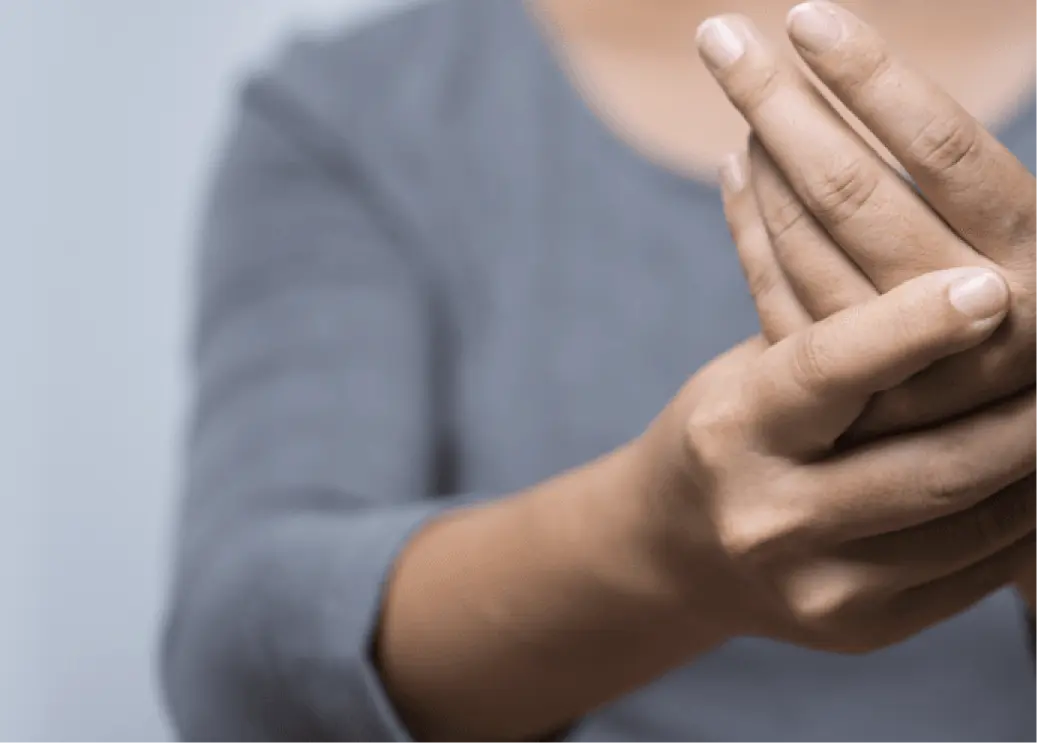Diagnosis
Do you have
Dupuytren’s contracture?

Over time, Dupuytren’s contracture can become debilitating.
Who gets Dupuytren’s
contracture?
Dupuytren’s contracture affects men more often than women, especially after age 50. However, in some cases, it can develop earlier.
Genetics play an important role. Those who are most likely to develop it tend to have Northern European heritage, especially people of Swedish, Danish, Icelandic, and Norwegian descent. This is why Dupuytren’s contracture has been nicknamed the “Viking disease.”
What causes Dupuytren’s
contracture?
The cause of the condition is unknown, but several factors appear to pay a role.
- Family history: Dupuytren’s contracture is usually hereditary and is the most common inherited connective tissue disorder.
- Epilepsy: Individuals with chronic epilepsy have been shown to have an increased risk of developing Dupuytren’s contracture compared to the general population. Antiepileptic drugs, like barbiturates, might be why. There may also be a genetic link between the conditions.
- Diabetes: Diabetes significantly increases the risk of developing Dupuytren’s contracture. Taking insulin and oral hypoglycemics may also be a contributing factor. Dupuytren’s appears to develop earlier and more severely in individuals with type 1 diabetes.
- Manual activities: Heavy manual work and exposing the palm to vibrations and repetitive trauma could also be risk factors.
- Alcoholism and liver disease: In genetically predisposed patients, drinking alcohol may increase the risk of developing Dupuytren’s.
- Tobacco use: Tobacco use is statistically linked to Dupuytren’s contracture. Smokers are three times more likely to develop the condition. Smoking also increases the likelihood of post-treatment complications.
- HIV: Individuals with HIV have also been shown to be at an increased risk of developing Dupuytren’s contracture.
What are the signs of
Dupuytren’s contracture?
Dupuytren’s symptoms appear over time:
- First, nodules and indurations, or small areas of hardened tissue, develop in the palm. Eventually, the fingers will start to curl inwards.
- Fingers will look stuck in the bent position, keeping the hand from opening and significantly affecting hand movement.
- The pinkie and ring fingers are affected most often.
- Aggressive forms of the condition will often affect the thumb or index finger.
How is Dupuytren’s
contracture diagnosed?
Your doctor can diagnose Dupuytren’s contracture based on your medical history and by examining your hands. They might prescribe an ultrasound to diagnose potential complications or rule out other hand conditions.
The condition progresses at different speeds for different patients. Most of the time, it progresses slowly over months or even years.
The tabletop test is a helpful way to assess how severe it is. This involves laying your hand flat on a flat surface. Surgery is recommended if full extension is no longer possible.
MEET YOUR HAND EXPERT
A first step towards recovery
What other conditions are
related to Dupuytren’s contracture?
Several hand conditions are directly linked. Individuals who have Dupuytren’s contracture should keep an eye out for possible symptoms related to trigger finger and carpal tunnel syndrome.
How can I tell the difference between Dupuytren’s
contracture and other hand conditions?
Dupuytren’s contracture is often mistaken for the early stages of trigger finger. While both cause one or more fingers to bend, they are distinct medical conditions. Trigger finger is caused by inflammation in the tendons, while Dupuytren’s affects the surrounding tissue. They present and progress differently
The telltale signs of Dupuytren’s contracture are the characteristic nodules and bands that develop in the palm. Unlike trigger finger, Dupuytren’s contracture doesn’t cause pain or audible clicks when you open your hand. Dupuytren’s contracture affects a much higher percentage of men, while trigger finger is more common in women.
If you’re unsure about your diagnosis, contact a hand specialist for a consultation.
Key
takeaways
_________________
What are the signs of Dupuytren’s contracture?
Dupuytren’s contracture is caused by a thickening of the fascia, the fibrous tissue under the skin of your palms and fingers. It starts with fibrous nodules that develop into hard bumps that limit the extension of the fingers (most often the pinkie and ring fingers). Eventually, the curling, known as contracture, leads to impaired hand function.
What causes Dupuytren’s contracture?
The exact cause of Dupuytren’s contracture is unknown. What we do know is that several factors increase the chances of developing it: family history, diabetes, epilepsy, injury or trauma, occupational stress, alcoholism, liver disease, tobacco use, and HIV.
Who gets Dupuytren’s contracture?
Dupuytren’s contracture is one of the most common hand conditions in people age 50 and older. Men are five to six times more likely to be affected.
How is Dupuytren’s contracture diagnosed?
A clinical examination and the identification of symptoms are usually enough to confirm a diagnosis.
What treatments are available?
Unfortunately, Dupuytren’s contracture can’t be cured, but non-surgical treatments can reduce discomfort during the early stages of the condition. Surgical treatment involves removing the affected tissue or stretching it after making small perforations with a needle.
Practical and comprehensive
medical guide
Everything you need to know to identify and treat Dupuytren's contracture. Written in clear and simple language by hand surgeon Dr. Jean-Paul Brutus, this e-guide identifies the causes, symptoms, and different ways to treat Dupuytren's contracture and offers recommendations on how to ease your symptoms at home.



IMPORTANT MESSAGE
Dr. Jean-Paul Brutus no longer performs surgeries. He now works as a specialized EXPERT-CONSULTANT in:
- COMPLEX CASES AND SECOND OPINIONS involving hand and wrist conditions.
- SELECTED MINIMALLY INVASIVE PROCEDURES (Dupuytren’s contracture, trigger finger, ultrasound-guided injections when indicated).
- MEDICOLEGAL ASSESSMENTS.
- RECEIVE A CLEAR DIAGNOSIS AND A CONCRETE PLAN to move out of confusion.
- Be REFERRED TO THE BEST SURGEON, within a trusted, carefully selected network.
- ACCESS MINIMALLY INVASIVE TREATMENTS, but only when they are truly appropriate.
PLEASE NOTE: We are not an injection center for external prescriptions. Such requests must be directed to a radiology clinic.